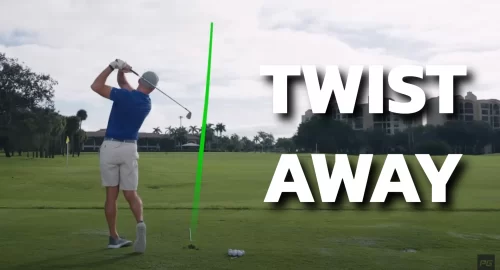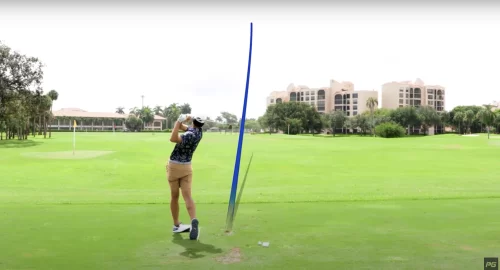
Are you tired of hitting your irons inconsistently? Do you want to hit more greens in regulation so you can lower your handicap? If so, you’re in the right place.
There’s nothing like the sound of a pure iron shot; it can happen easier than you think when you focus on the basics. Today, we’ll simplify ball position for each type of iron and provide tips so you can achieve better contact than ever before.
Hitting Golf Irons Like a Pro
To hit your irons flush, you need the right setup which includes alignment, ball position, and grip. Paired with the right takeaway, weight shift, and tempo, you’ll hit it better than ever.
Start by checking your grip, and make sure it’s in a neutral position. If you hit a lot of slices, chances are a weak grip is to blame.
Once your grip is correct, use alignment rods to check your aim. A common mistake with golfers is aiming too far right, which leads to issues in the downswing and inconsistent contact. Make sure your feet, hips, and shoulders are square to the target so you can have a good swing plane and not get too steep.
After your grip and alignment are good, the right ball position and placement is key to striking your irons pure. We’ve covered golf ball position for each type of club but want to elaborate with golf irons as each type (long, mid, and short) requires a different position in your stance.
Guide to Golf Irons Types
In this section, we’ll break down the key distinctions between these clubs, including loft, length, and ideal use cases, so you can approach your iron game with confidence. Whether you’re aiming for distance, control, or finesse, mastering these clubs is your first step toward becoming a more well-rounded golfer. We’ll also cover ball position for each type, which is a crucial step.
Regardless of your iron type, avoid positioning the ball too far up in your stance, as you’ll hit the ball on the upswing and likely low on the face, resulting in a thin shot. If you’re considering an extremely easy iron to hit that’s very forgiving off the toe or heel, consider the AnyLie hybrid as an alternative.
When you’re done with this article, be sure to check out our YouTube video all about compressing and hitting your irons pure, led by golf coach Grant Horvat.
Long Irons
Long irons are anywhere from a 2-5 iron.
However, most iron sets don’t come with a 2 or 3-iron anymore, and some don’t have a 4-iron either. This is because golfers understand how hard these clubs are to hit consistently well, even for the best players in the world.
Longer irons are challenging to hit because of the small clubhead, length, and loft. Without solid fundamentals and higher swing speeds, it’s difficult to hit them correctly.
We’d recommend most golfers swap out traditional, hard to hit long irons with hybrids and utility irons instead. These designs are much more friendly, easier to launch higher, and much more forgiving on mishits.
Regardless of if you’re hitting hybrids or long irons, make sure you have the right ball position. The ideal spot in your stance is in the middle front part of your stance. This will help you make a small divot and a clean strike.
Mid-Irons
Mid-irons consist of 5, 6, and 7-irons. These golf irons are easier to hit than long irons since they’re shorter and have more loft, making them easier to control. Ball position for these irons is just ahead of the center of your stance.

Short Irons and Wedges
Short irons include a PW (pitching wedge), 9-iron, and 8-iron. These clubs are shorter than mid-irons and have more loft, making them easier to hit.
So, what about ball position? With these clubs, you want them slightly further back in your stance than mid-irons, typically about the middle of your stance. This will help you make ball first contact and make a good strike.
When it comes to wedges, you should play them between the middle of your stance to even slightly further back. One of the biggest mistakes many amateur golfers make is getting the ball too far up in your stance with wedges. This makes it easy to hit the ball on the upswing, not make a divot, and hit a lot of shots thin.
If you struggle hitting wedges consistently, experiment with the ball position slightly further back in your stance.
Additionally, don’t forget to try out the ONE Wedge. This revolutionary design is easy to hit for all types of players for full shots, bunkers, and around the green.
Changing Ball Position With Irons
You can slightly change your ball position with irons to impact the trajectory and shot shape. This is something you can’t do with a driver, otherwise you’ll have a steep downswing and probably get a skymark on your driver.
But luckily for beginner golfers, there is some wiggle room with irons. For example, if you want to hit a fade, move the ball one ball ahead in your stance to encourage a more left to right ball flight. Or, if you want to hit a draw, move the ball position one back in your stance to push your path right and encourage a right to left ball flight.
This can also help if you’re out of position and need to hit a fade or draw to avoid a tree and get back in position. Experiment with different positions in practice to see how it helps with your desired shot shape.
Ball Position for Punch Shots
Sometimes you’ll hit a wayward drive and be forced to punch out to get back in position. To hit these shots, you’ll need to pick the right iron for the shot and change your setup.
Start by evaluating how low you have to keep the ball. The lower the trajectory you need, the longer iron you should take.
Once you have the right iron for the shot, play the ball in the middle of your stance – even if it’s a long iron. This will help keep the trajectory down and avoid tree trouble.
Avoid putting it too far back in your stance, as you’ll get steep and won’t be able to make great contact.
Hitting Golf Irons Like a Pro
Now you have a blueprint to hit your irons better than ever.
When you have the right setup positions, it makes it a lot easier to make consistent contact and avoid fat or thin shots. Whenever you’re out on the driving range or in the simulator, make sure that alignment and ball position are always a priority.
Additionally, don’t be afraid to play more forgiving irons, including a combo set to replace hard to hit long irons. Using hybrids – like the AnyLie – can make golf a lot easier and improve your game from long range.
Once you have your iron ball position correct, next focus on your short game and on the golf ball position on the green.

